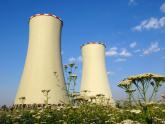Will the Nuclear Sector Rise Again?

Just as the nuclear renaissance was getting its legs, the earth crumbled beneath it. But will the industry rise again and if so, when?
The devastation in Japan along with the nuclear crisis there means that the disarray will continue. The prudent step to take both here and abroad is to remain rational and to properly assess the situation before making any firm decisions. That entails reviewing the current safety designs along with the specific factors contributing to the accident at the Fukushima Daiichi nuclear plant.
“We are always focused on the safety and security of nuclear power plants in this country,” says Nuclear Regulatory Commission Chair Greg Jaczko, who emphasizes that the federal agency is independent. “Whenever there’s any new information we always take that information into consideration and make changes if necessary. All our plants are designed to withstand significant natural phenomena like earthquakes, tornados and tsunamis.”
The Nuclear Regulatory Commission has said that the rods at the site containing spent nuclear fuel have been exposed. The International Atomic Energy Agency has confirmed this, explaining that those rods generate such intense heat that they need to be constantly cooled. That provides protection from radiation. Because the backup generation that serves to pump water into the spent fuel pools didn’t perform, radiation has leaked. It is too soon to know exactly how much radiation has escaped and what the effects of that will be.
In its most simplistic terms, the rods containing the uranium sit in the “core.” That core is encased in a containment vessel. That structure is solidified with cement and steel. After the fuel is used up, the containment vessel is lifted and the spent material is placed in adjacent cold pools. After it is sufficiently cooled, it will be stored in above-ground concrete dry casks.
“To have backup generators in place where they can be washed up or destroyed seems to me to be a systemic failure,” says George Frampton, who was the lead investigator during Three Mile Island and who is now a partner in the clean energy practice of the Covington & Burling Law firm in Washington. “Clearly, if all they could all be taken out by a wave, the system was not fail-proof.”
Sensible Approach
Experts say that the reactors on this one site all survived the mammoth earthquake. But it was those gigantic waves from the tsunami that knocked them out. The obvious question then becomes what does this mean for any nuclear reactor that sits in a potential danger zone?
As for Japan, it has no domestic oil and gas industries. It must rely on nuclear energy to generate about a quarter of its electricity, all from 55 separate facilities. About 13 nuclear reactors are under construction there. And prior to the most recent natural disaster, Japanese officials said nuclear’s role would grow.
In the United States, 104 nuclear reactors are now generating 20 percent of the electricity using "second generation" light water facilities. So-called "third generation" light water reactors have been built overseas and particularly in Asia. Those have multiple safety measures and are designed to cope with any sudden loss of cooling, meaning those future plants would not experience what has been occurring to the ones in Japan. Fourth Generation plants are being devised and will be available for licensing and sale after 2020.
“We can’t design for unimaginable contingencies,” says Jim Fracher, who is a member of the IEEE-USA Energy Policy Committee and who has worked at several nuclear plants. “We have to make certain assumptions to determine how likely events are. The new reactors in the queue are substantially more robust than the reactors we are talking about in Japan. A sensible approach still means the nuclear program in this country won’t die.”
The global community will come together to analyze what occurred in Japan and then apply those lessons to both existing and prospective nuclear facilities. Here, the Nuclear Regulatory Commission has already affirmed that it will take that new information and ask current operators to embed that data into their safety designs -- technology that will also apply to those in the planning stages.
Will that be enough to get the nuclear sector back on its feet? Asia is well on its way to building more units. While plans to construct new ones are on the drawing board in both the United States and in Europe, they will at least be delayed because of safety and financial concerns. Resurrecting the movement entirely will require full disclosure as well as like-minded consortiums that will risk their money.
EnergyBiz Insider has been named Honorable Mention for Best Online Column by Media Industry News, MIN.
So what do you think? Please share your thoughts by posting a quick comment below, or by sending a longer reply to energybizinsider@energycentral.com.
Follow Ken on www.twitter.com/freehand1200
Copyright © 1996-2010 by CyberTech, Inc. All rights reserved.
To subscribe or visit go to: http://www.energycentral.com
To subscribe or visit go to: http://www.energybiz.com